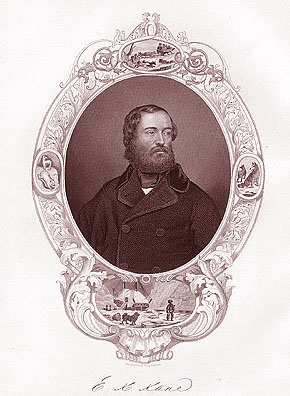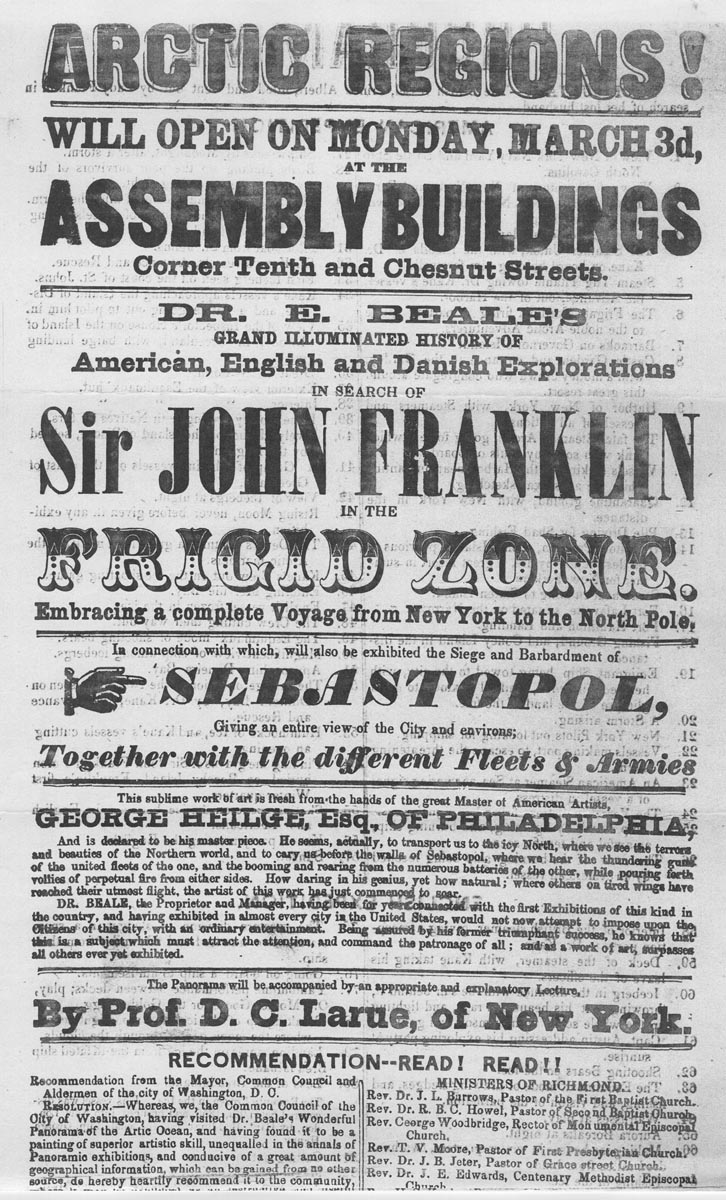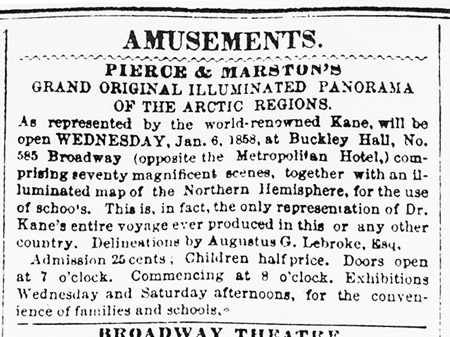
The
Arctic Panoramas of Elisha Kent Kane
© 2000 Russell A. Potter

The
Arctic Panoramas of Elisha Kent Kane
© 2000 Russell A. Potter
Between 1855 annd 1863, there were no fewer than four different Panoramas based on Kane's Arctic expeditions touring the United States. One, commissioned near the time of after Kane's death, featured personal narration by William Morton, Kane's "faithful friend" and one of the chief heroes of the Second Grinnell; not to be outdone, a rival panoramist secured the services of Thomas Hickey, another Kane crewmember. These panoramas criss-crossed the nation, sometimes appearing in the same town and engaging in a duel by means of newspaper advertsements in which each claimed to be larger and more authentic than the other.
The earliest
Kane Panorama -- and the longest-lasting -- Dr. E. Beale's, was painted
by Philadelphia-based scene painter George Heilge, and appeared at the
Odd Fellows' Hall in Washington D.C. late in 1855, before Kane had returned
from his second expedition. It moved on to a tour of eastern cities,
arriving in Kane's home ground of Philadelphia in May of 1856, from which
appearance the handbil below derives:

Panorama of Dr. Kane's Arctic Voyages, from the collection of the Library Company of Philadelphia. Reproduced by permission.
Dr. Beale's show soon found a rival with a Panorama produced by John Treadwell, who worked closely with Kane's estate and secured the services of William Morton as its narrator. Treadwell's and Beale's shows competed directly against one another in Philadelphia, New York, and Boston, but late in 1856 Morton became disgruntled and left the Panorama, his place taken Charles Gayler, by a popular stage actor of the day. With Gayler, the Treadwell Panorama moved on to the Brooklyn Athnæum early in 1857, after which is vanished from sight.
In the interim, several rival shows appeared, including one operated by George Goodwin, a highly successful panoramist in Boston; Goodwin's show upped the ante with a life-size wax figure of Kane, as well as appearances by an "Esquimau" said to be "Hans," Kane's guide from Greenland (the actual Hans was still in Greenland -- it's not at all certain who this "Hans" was).
Among
the rivals for the public's attention, Pierce and Marston's Grand Original
Illuminated Panorama of the Arctic Regions certainly had the grandest title;
it appeared in New York in January of 1857 while Gayler was still narrating
the Treadwell panorama a few doors down on Broadway. Evidently, it
suffered by comparison, as it closed after a week and nothing more was
heard of it:

A third
rival show, Wolfstenberger's Great Mirror of the Arctic Regions, brifely
appeared at the Hope Chapel on Broadway in December of 1860.
Dr. Beale's show, of which a number of copies appear to have been painted, supposedly appeared in London late in 1857, and was seen by Lady Franklin and Queen Victoria, the latter of whom presented Thomas Hickey with a medal. After its return to the United States, it incorporated scenes apparently taken by stitching in rival panoramas, growing by leaps and bounds until it was nearly double its original size. It continued to tour the country until 1862, when it finally came back to a permanent home at the Philadelphia Natatorium, where Dr. Beale rebuilt the second floor for its permanent display (it was rotated with another of his shows, "Beale's Western World").
Between
1855 and 1863, upwards of a hundred thousand Americans saw these Panoramas
of Kane's exploits; of American heroes to exploration, he stood alone.
Yet after the Civil War, his fame faded, and the Kane panoramas faded with
them. None of the Kane Panoramas has survived to this day.
References
Russell
Potter and Douglas Wamsley: "The Sublime yet Awful Grandeur: The Arctic
Panoramas of Elisha Kent Kane."
The
Polar Record 35:194 [July 1999] (Cambridge University Press).